....pane jo  děkuju za článek..toto jsem potřeboval
děkuju za článek..toto jsem potřeboval 
Metal detector Tesoro EuroSabre II six-month test
Categories: Tesoro EuroSabre II metal detector
Detector description
It is probably best to start with a description of the detector. EuroSabre II is a single frequency VLF metal detector. The detector is analog-digital, which means that the detector response is not digitally processed. However, the correct operation of all its functions is monitored by the processor, which brings a number of advantages, especially for detectorists who like subtle nuances in the response. The instrument operates with three discriminating modes and an All Metal mode. This gives the detector great variability in settings and very fast target checking. The very low weight of the detector is a chapter in itself. I don't think there is really any detector on the market with the performance of the EuroSabre II and weighing one kilogram. The detector comes with a number of additional probes. The unit can use all the probes for the uMax series, plus there are two 9x8" and 12x10" concentric probes, specially made for the EuroSabre II only. I will mention the 12x10" concentric probe at the end of the test. This is a completely new product, which came on the market on 18.4.2010. The instrument has very accurate ground effect tuning, can be disassembled into three parts and is powered by a single 9V battery.
First steps and polygon
When the first EuroSabre II arrived, I eagerly took apart the familiar Tesoro box and quickly assembled the detector. The instrument is all black and I think, in conjunction with the colourful description of the controls, you could say it's really attractive :) Assembling the detector is as easy as with all Tesoro instruments and will take you no more than five minutes, even if you are doing it for the very first time. I quickly set up the instrument on the polygon, debugged the ground effect and ran through each target. In general, I believed the instrument would again bring a shift in range and evaluation. But the result surprised me so much that the very next day I showed the instrument to our dealers with a lot of joy (see detailed table of ranges measured in Jílové later in the test).
Detector settings
Before I start describing the pros and cons of the detector and my own feelings when using the device, I will first describe its proper setup. I think this is very important. The functions that you will find in the video will be marked in red.
Setting up the ground effect detuning
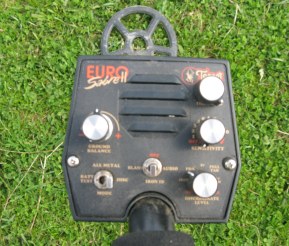 The exact setting of this function decides almost everything. Thanks to the soil detuning, you can have a detector perfectly still in every location, just as you will be able to add an inch of range in places that will be worth it from your point of view thanks to the detuning.
The exact setting of this function decides almost everything. Thanks to the soil detuning, you can have a detector perfectly still in every location, just as you will be able to add an inch of range in places that will be worth it from your point of view thanks to the detuning.
The ground tuning is done in one way, the so-called"pumping". Find a clean spot with no metal present and move the probe between 2cm and 20cm. The result you should achieve is an unchanging treshold tone. When tuning the soil, I recommend setting the sensitivity low - 1 or 2. The Threshold tone should be set at an audible level when detuning. The tuning itself is then done in All Metal mode. A full and accurate description can be found in the manual, but what is missing is a description of the minor differences in settings.
Once you start to master the settings, which won't take long as it is a very simple task, you can start experimenting a bit. The detector can be set up incredibly accurately. With classic tuning, you will very quickly find a position where your tone goes up and down equally. If you then slowly start to lower the volume of the threshold you will find that you can fine tune the level again. Gradually you can achieve a perfectly fine tuned detector, giving you a very "silent" search with virtually no ringing, which many searchers really appreciate. Simply then every "sound" is really a target. If you have mastered detuning to this level, you can experiment further.
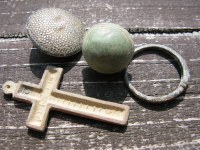 If you want to squeeze the maximum performance out of the EuroSabre II, you can start using what is called "negative ground detuning". Basically, this means that you set your detector so that your tone only goes up. If you do this too roughly, while the detector's range will literally be dreamy, the instrument will have a lot of ringing, which will make searching very unpleasant. The solution is to adjust the negative ground tuning very gently. When you have learned to detune the ground effect as I described in the previous paragraph and have achieved a very accurate level of ground detuning, turn the Ground Balance potentiometer about two millimeters more toward the minus sign. This change is only slightly noticeable in tone, but quite noticeable in range (an extra 1g silver coin by about 2 to 3cm which I consider to be a more than respectable result).
If you want to squeeze the maximum performance out of the EuroSabre II, you can start using what is called "negative ground detuning". Basically, this means that you set your detector so that your tone only goes up. If you do this too roughly, while the detector's range will literally be dreamy, the instrument will have a lot of ringing, which will make searching very unpleasant. The solution is to adjust the negative ground tuning very gently. When you have learned to detune the ground effect as I described in the previous paragraph and have achieved a very accurate level of ground detuning, turn the Ground Balance potentiometer about two millimeters more toward the minus sign. This change is only slightly noticeable in tone, but quite noticeable in range (an extra 1g silver coin by about 2 to 3cm which I consider to be a more than respectable result).
Although you probably won't set the ground this precisely at the beginning, you don't have to be sorry. The range of the detector is still excellent. However, every searcher is constantly trying to push his detector further, so after some time using this method you will definitely find it useful.
Sensitivity setting
The sensitivity level setting is the second most important task. After you have tuned out the ground effect, you should set the sensitivity correctly. This affects the range of the detector and also the sensitivity to small objects. Too high a sensitivity setting, however, can cause unstable detector behavior and false targets. A very simple way to adjust the sensitivity is to find a clean place with no metal targets and set the sensitivity to maximum. In 90% of the cases you will get a "chipped" detector. If it does not, the soil at that location is very slightly mineralized. Slowly, millimeter by millimeter, lower the sensitivity setting until you find the point where the "chatter" stops. This is the point of the highest possible sensitivity setting for the site. If you do the same, you will always have the detector set to the maximum the detector can tolerate at the location you are looking for. But at the same time, you will have the detector completely quiet!
Discrimination settings - Audio disc, iron disc and blank mode
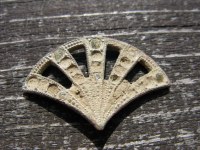 The detector uses three discrimination modes, which brings a number of advantages when evaluating a target. Also, it can often happen that a setting that is good in one location may prove to be weaker in another. It's also all very much up to the feel of each individual searcher, so how and where I set the discrimination is always at least partially subjective. At this point I should also write that I always try to save discrimination, and my own approach is to "hear as many targets as possible".
The detector uses three discrimination modes, which brings a number of advantages when evaluating a target. Also, it can often happen that a setting that is good in one location may prove to be weaker in another. It's also all very much up to the feel of each individual searcher, so how and where I set the discrimination is always at least partially subjective. At this point I should also write that I always try to save discrimination, and my own approach is to "hear as many targets as possible".
Audio-disc: For all intents and purposes, a very interesting mode that you will be walking around in very often. Targets are differentiated tonally, irons grumble, colours squeak. The third, middle tone is "croaky" and indicates harder to identify targets. Very often the tones are mixed, which means that, for example, you will hear a high tone and a mid tone at the same time. Or a low tone and a mid tone with it. From my own experience, I can tell you that targets that have a high and a mid tone should always be kicked. Objects that are marked with a low-mid tone are a bit about the practice of the seeker. If an object echoes primarily with a deep tone and the mid tone only occasionally echoes, it will be a hammered nail, for example. If a more predominantly medium tone, it will be an object where iron is mixed with some non-ferrous metal. A good example of this is zinc buttons with an iron bottom. In general, however, tonal evaluation works very reliably, and its big plus is that even very minor objects, such as the smallest silver coins weighing up to 1g, are always and only reported as colour targets! This is an excellent testimonial for the detector and significantly differentiates the device from the vast majority of detectors in this class.
Note: do not use the discriminator in this mode, I think the best use of the detector in audio-discrimination is when the discriminator is set to the absolute minimum.
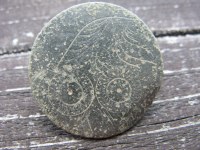 Iron ID: The classic Tesoro discriminator mode that all users of Tesoro detectors are used to. Since this is a rellic detector, the discriminator is set very finely. Its settings remind me a bit of Tesoro Tejon, although I think Tejon is one level more sensitive. For complete discrimination of most ferrous objects, you need to set the discriminator up to almost the Foil marking. I don't recommend setting up the detector that way though. If you want to discriminate iron, it is more interesting to set the discriminator only just above the Iron marking. This will have several advantages for you. First of all, you won't lose any of the detector's range on the smallest objects. I also find it much more satisfying to hear a "sizzling" tone on larger pieces of iron, which is absolutely characteristic. The detector then also has even better separation properties, which are very good with this device, so there is no reason to make them worse.
Iron ID: The classic Tesoro discriminator mode that all users of Tesoro detectors are used to. Since this is a rellic detector, the discriminator is set very finely. Its settings remind me a bit of Tesoro Tejon, although I think Tejon is one level more sensitive. For complete discrimination of most ferrous objects, you need to set the discriminator up to almost the Foil marking. I don't recommend setting up the detector that way though. If you want to discriminate iron, it is more interesting to set the discriminator only just above the Iron marking. This will have several advantages for you. First of all, you won't lose any of the detector's range on the smallest objects. I also find it much more satisfying to hear a "sizzling" tone on larger pieces of iron, which is absolutely characteristic. The detector then also has even better separation properties, which are very good with this device, so there is no reason to make them worse.
Blank: special mode for discrimination of deep irons. Tesoro In this mode, it attempts to solve the problem of many European prospectors moving to sites contaminated withsmall but deeply buried iron targets that have a very confusing effect for many detectors. The mode is processor-driven and has a different behavior from the classic discriminative modes Tesoro. Basically, the way it works is that when an iron target is received by a detector, the "blank" evaluates it and then either tries to hide it or not. In practice, this may sound like you get a very short audio signal at first, which is then hidden. In really iron infested places this is very usable and will shorten your search of the site. "Blank" works very accurately, but it also has its weak point. For example, small iron cartridges, which are usually reported as coloured targets, are reliably hidden by the detector in this mode. I have tested a number of objects in this mode that I would certainly not want to lose in a search. Even small silver and gold objects were not discriminated by the detector. Still, I would use this mode mainly in places where it makes sense. Thus, if you are digging from great depths one head of forged nail after another in a particular location, "Blank" is certainly a very good and fast solution.
Note: In Blank mode, I recommend not setting the dissiminator, leave it set to the minimum.
Threshold setting
Setting the Threshold Tone is important on three counts. When tuning the detector, the threshold tone should always be set somewhere at the audible level. The same setting, or even slightly lower, is appropriate for searching in All Metal mode. In discriminating modes, the threshold can be set to the maximum. If you do this, you get a hair better sensitivity to small objects and a louder response from all other targets.
Working in All Metal mode
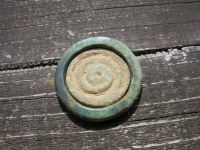 Working in this mode has its own specifics and laws. Most searchers use the fast-tuned All Metal mode, which Tesoro detectors primarily use to pinpoint objects. However, the mode has a much broader application and when using headphones in it you will be able to track a number of targets that may be hidden to most detectors. However, working in this mode can be tedious for some searchers, especially in areas that are target rich, this is a search mode primarily for experienced searchers. However, it is definitely true that when working in this mode, the detector should have the threshold set to the audible level. If you are using headphones, you can set this level even lower - you just need to threshold to perceive even the slightest signal change.
Working in this mode has its own specifics and laws. Most searchers use the fast-tuned All Metal mode, which Tesoro detectors primarily use to pinpoint objects. However, the mode has a much broader application and when using headphones in it you will be able to track a number of targets that may be hidden to most detectors. However, working in this mode can be tedious for some searchers, especially in areas that are target rich, this is a search mode primarily for experienced searchers. However, it is definitely true that when working in this mode, the detector should have the threshold set to the audible level. If you are using headphones, you can set this level even lower - you just need to threshold to perceive even the slightest signal change.
Many times I have encountered that even more experienced searchers do not use this mode at all. They often argue its fatigue and the range of targets. Usually, however, the problem is rather in the sloppy tuning of the ground effect (this is generally true for all detectors with manual ground tuning with active threshold). The more accurately you adjust the ground balance, the more enjoyable and rewarding you will find working in All Metal. The well-placed controls make it easy to switch between All Metal and discriminating mode with the thumb of the hand holding the detector. Everything works very easily and you can practically check immediately whether the target is iron or non-ferrous metal. If the signal is very weak or completely indistinct, then it's definitely worth kicking the ground a bit. It makes sense to do this, but only in locations that are worthwhile or in places where there are very few targets.
Detector evaluation - practice and a few types
My own detector evaluations will of course be subjective and should be viewed as such. Nevertheless, I will try to describe the practice with this detector as detailed as possible, because I am convinced that this instrument really deserves it.
I have used the detector both in the winter months and all spring, plus of course in November and December before the snow fell. I can thus declare that the detector does not care what time it is on the thermometer. My first search this year was in temperatures of about -13°C. We walked one known retreat, there was nothing else to walk, because everywhere else there was still too thick layer of snow. So I can only say that if you try to tune the ground balance on a thicker snow layer you will not succeed. The tone is basically the same all the time and the detector has nothing to detune. In this case it is best to set some sort of medium value like the Air test. For smaller snow layers (up to 5cm) it is worth ploughing the snow off and tuning directly to the ground when detuning. The detector proved itself in freezing weather without losing a flower, unlike my guaranteed waterproof trekking boots. My frozen feet continued to thaw for hours after I got home :).
What I admire most about the detector is its variability of search modes. There are no extra features, the detector is, as all Tesoro users are used to, always equipped with only and only what the searcher will actually use in the field. Under the slogan "Simplicity is Strength" one can agree with this approach and certainly the view of the two Gifford brothers, who are themselves searchers and thus look at detectors primarily from the practical side of field use.
Ground balance tuning is very easy to use with the EuroSabre II. In my opinion, and that of my friends, the ground balance setting on this detector is the easiest of all detectors Tesoro. The tone of the threshold and its change is distinctive which makes everything easier especially for beginners.
Personally, I liked using the Audio-disk mode the most. Only if the site was really iron-infested and I, already tired, switched to the classic discrimination mode. Thanks to the mixing of tones in Audio-disk, you have the opportunity to grow with the detector for a long time and to tighten the use of the instrument to absolute virtuosity. A good example of this is the iron ring. Its centre whistles and the edges growl. It's a good thing when a first-time detectorist digs up such a target to understand what the detector is telling him. The resolution works impressively, though.
Classic Tesoro discrimination works like Tejon's. While I find it a bit coarser, it is still very versatile and if the searcher is used to discriminating large iron from smaller ones using the discriminator, and generally when looking for iron targets, very usable. I have used this mode mainly when I was getting a bit tired of the tone response. In doing so, I also used the method of switching to Audio and checking the target. Comparing the two modes avoids unnecessary digging. In the beginning, though, I dug every suspicious target. The EuroSabre II doesn't get confused very often, though, so you can rely on the answer.
Blank mode is then best used especially in places with a lot of ferrous waste. Processor-driven discrimination will hide anything really, but will admit a large iron object as a color (horseshoe, etc).I was a bit nervous about the "blank" hiding, for example, small iron cartridges (I'm not a hunter so I have no idea what they are called, but they are only a few millimeters in diameter).
The behavior of "blank" is different from the classic discriminative modes Tesoro. These may sputter once or twice when receiving an unwanted target of smaller size. For a larger piece of iron, they sizzle. Blank will, in the vast majority of cases, "sizzle" only once and then hide the object. However, with large pieces of iron, there is a clear response in the paint and the detector in no way warns you that it's probably not the right thing to do. So I see the mode as best used in exactly the cases for which it was designed, i.e. for eliminating large numbers of smaller iron targets at depths at the limit of range. These are an intractable problem for a large number of detectors!
Conclusion
The EuroSabre II metal detector is a device that has succeeded in every respect, as evidenced by the number of searchers who use it in the Czech Republic today.I must apologize to many of them for the delay in this test, but this winter has been a really long one and I didn't want to rush anything. Two autumn months were really not enough.
The operation of the detector is simple and pleasant, as is the scale. Even a complete beginner does not have to worry about not mastering the device in a relatively short time. The alpha and omega of the range and the calm course of the search is the detuning of the soil influence. In the video at the end of the test, I have given it maximum time and hope that this will help anyone who might be groping in this function of the instrument. From my point of view, it is a very simple task and it takes a few seconds at most to debug the instrument. However, it is understandable that if someone hasn't done it, they may not know how to do it right away.
I don't think there is any need to overdrive the detector, the range is still very decent. I used to walk around with the detector on headphones, so I also kept the threshold tone level set to the audibility threshold. This gives you a better chance when switching to All Metal to detect how big the object is and how deep it is buried.
But in the end, each searcher will find his or her own style with the detector, so I can only wish everyone the best of luck with this unique device and don't forget to push the coil :)
Elmara
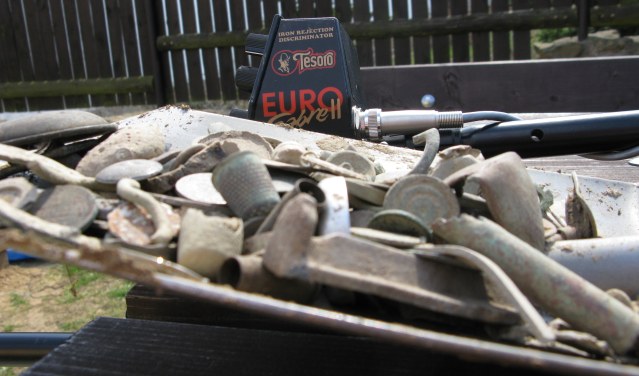
Last day of EuroSabre II tests, it's just a pity I didn't add at least one Ag :)
Table of ranges measured in Jílové u Prahy for EuroSabre II
| Subject | Description | Sensitivity 9 | Max Boost | Slightly negative ground tuning - see video |
 |
First war military badge 45mm diameter |
30 cm | 34 cm | plus 3cm |
 |
Two-Halers Austria-Hungary Diameter 19mm |
19 cm | 23 cm | plus 1cm |
 |
One crown of the Czechoslovakia Diameter 23mm |
23 cm | 25 cm | plus 2cm |
 |
1 krejcar Ag Silesia Diameter 14 mm |
19 cm | 20 cm | plus 2cm |
 |
1 penny Vratislav Jagiellonian Diameter 9 mm busted |
11 cm | 13 cm | plus 1cm |
 |
Half belt buckle. Length approx. 46 mm |
28 cm | 32 cm | plus 2cm |
 |
Deformed cartridge case. Length approx. 50 mm |
26 cm | 31 cm | plus 2cm |
Hot news from Tesoro EuroSabre II limited edition
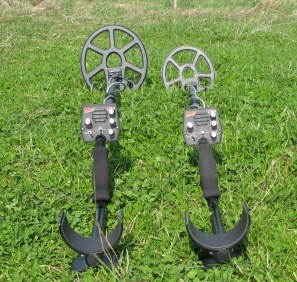 On Friday 16.4 the first detectors from the EuroSabre II limited series arrived. These detectors feature a brand new 12x10" concentric probe in black.
On Friday 16.4 the first detectors from the EuroSabre II limited series arrived. These detectors feature a brand new 12x10" concentric probe in black.
All Tesoro detectors have precision manually adjustable probes. However, the limited series probes are set to the electronics of the specific detector and so there is a maximum reduced tolerance. The probes have the same number as the detector number and so will always be the best coil you buy for the detector.
Like other Tesoro EuroSabre II detectors, the instruments in this special edition are capable of using all probes designed for the uMax series.
At the very least, we took measurements on the polygon over the weekend and spent several hours in the field with the detector. The results can be found in the table below.
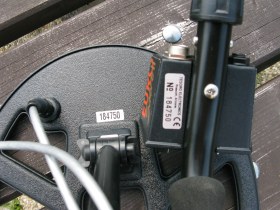
Table of ranges measured in Jílové u Prahy with EuroSabre II limited series (new probe 12x10")
| Subject | Description | Sensitivity 9 | Max Boost | Slightly negative ground detuning - see video |
 |
First war military badge 45mm diameter |
33 cm | 35 cm | plus 2cm |
 |
Two-Halers Austria-Hungary Diameter 19mm |
22 cm | 24 cm | plus 1cm |
 |
One crown of the Czechoslovakia Diameter 23mm |
25 cm | 27 cm | plus 2cm |
 |
1 krejcar Ag Silesia Diameter 14 mm |
19 cm | 21 cm | plus 1cm |
 |
1 penny Vratislav Jagiellonian Diameter 9 mm busted |
12 cm | 14 cm | plus 1 cm |
 |
Half belt buckle. Length approx. 46 mm |
32 cm | 34 cm | plus 2cm |
 |
Deformed cartridge case. Length approx. 50 mm |
29 cm | 31 cm | plus 2cm |
Video
The video shows a demonstration of the detector, its functions and settings.
The article is included in categories:
- Archive of articles > Metal Detectors - Reviews and Tests > Tesoro - Reviews and tests > Tesoro EuroSabre II metal detector
Post
Mám ES II LS, zapnul jsem ho jen na půl hodiny, a už teď si chrochtám. Zítra jdu na celý den! K Lobu to bude perfektní doplněk.
Elmara - díky za tvůj pohled na ES II popsal jsi to úplně suprově.A tebou naměřené dosahy sedí. Já měl ve Sloupu 1 Kč na 26 centimetrech a Ag 0,8 g x 10 mm ve 12 centimetrech.
Voxi- tak ty jsi Lobu nevěrný. Rovnou si dej na Lobo inzerát, už ho nebudeš potřebovat. ES II tě dostane. 



Dobře udělaný test.Pokud by někomu neseděli dosahy ..tak si uvědomte ,že u vás je taková zem..a o pár km dál je už jiná..  ..Píšuto jako člověk co tento detektor testoval sám pro sebe..a tudíž nezávisle na na tomto webu.
..Píšuto jako člověk co tento detektor testoval sám pro sebe..a tudíž nezávisle na na tomto webu.
TO Shorty: neustálým experimentováním s nastavením GB do lehce negativně jsem dostal ESII ještě podstatně hlouběji. S větší sondou 12x10 jsme 3 krejcar pepíkaI dostaly na 36cm! Je to samozřejmě šust, ale oboustraný. S ESII se dá docela dlouho růst, a určitě se najdou hledači kteří ho vymáčknou ještě dál. Ostatně u Libora ne takovém našem testovacím místě bral Šimon zakopanou 1kč v 35cm.
Já jsem do tabulky uvedl pouze v půdě naměřené hodnoty, které mohu s normálně nastaveným ES II každému kdo do Jílového přijede předvést. 
Ono to měření ve Sloupu bylo docela neobjektivní. Pod povrchem byly zřejmě nějaké instalace a některé detíky tam absolutně nešly odladit.Třeba F75 bylo nutné stáhnout na 45 procent citlivosti kvůli interferenčnímu rušení. Já jsem také nijak neexperimentoval s nastaveními,polygon jsem jenom prošel a dost. Vím že se dá vyšťavit na větší hloubku,ale tam to nešlo.A to že detík signalizuje Ag jako barvu až na hranici dosahu je pravda. Buď barva a nebo nic.
EuroSabre se Giffordům opravdu vydařil. Díky jim a tobě za péči o nás jako věčné nespokojence. 



Díky za tento test je to fakt skvěle popsaný,sám mám tento detektor týden a měl jsem z toho přechodu z digitálu trochu obavy,ale musím říct ,že úplně zbytečný.První moje dojmi sním jsou velice pozitivní a určitě sním nebude mít problém ani úplný začátečník a už vůbec ne po takto popsaném testu a očekávaném videu.Ještě jednou díky 
Díky Elmaro. Parádní testík. Myslím že nejsem sám co můžu užasle rozmýšlet a číst a studovat znovu a znovu. Doufám že ho brzy uvidím v akci a hlavně v režimu audio disk. A to s tou limitovanou edicí a přesně sladěnými cívkami zní taky velice dobře.. A vůbec, máte taky někdo něakou tu kritiku? Taky by mě zajímalo, jak si poradí s tenkým zlatým řetízkem.. jestli ho při této frekvenci a kombinaci režimů uvidí.. Kdyby byl někdo tak hodnej. Jen pro představu. Jinak teda paráda a moc dík. Už se těšim až se setkáme 


Atos- jediná výtka tomuto detíku je, že mu chybí regulace hlasitosti repro. Opravdu jen tato jediná chyba se najde. 



SHORTY- To je škoda, ale myslel jsem si to  Nejspíš kámen úrazu takřka asi většiny detíků.. No a neustále si potit uši v letním parnu pod sluchátky.. Ale co by jsme pro ticho v lese neudělali
Nejspíš kámen úrazu takřka asi většiny detíků.. No a neustále si potit uši v letním parnu pod sluchátky.. Ale co by jsme pro ticho v lese neudělali 
 Ale konečně něaká kritika
Ale konečně něaká kritika  Diky
Diky 
mám dotaz nevíte někdo proč na oficiálních stránkách www.tesoro.com o něm nepíší díky za odpověď.. 
Zdravím. Nejdříve musím pochválit pěknou a rozsáhlou recenzi. Velice se mi líbil fígl se záporným nastavením GB pro vyšší dosah. V souvislosti s odladěním země chci upozornit na jeden fakt, který tu nezazněl. Odladění země je u detektorů Tesoro opravdu velmi jemné a přesné. To umožňuje použití detektoru ve složitých podmínkách, ale zároveň se stává, že se detektor velice snadno „rozladí“. Respektive se stane, že poměrně rychle opustíte podloží, pro které byl detektor odladěn. Rozhodně to nepovažuji za chybu detektoru, pouze je třeba mít toto na paměti a pokud možno co nejčastěji kontrolovat nastavení GB. Za krátký čas člověk odhadne dle terénu, kdy je potřeba kontrolovat GB více či méně. Je to stejné jako s posloucháním tónu – ze začátku holt kontrolovat častěji 
TO Jonny: EuroSabre II je zatím pouze pro evropský trh, ten je z pohledu Tesoro opravdu velice malý. Je to tak trochu i Česko-Slovenský projekt 
TO Fox: Na 90% se zem nehne za celý den. Pro kontrolu není potřeba udělat nic jiného než zakývat sondou v All Metal nahoru a dolu. Takže v podstatě můžeš zem kontrolovat při každém dohledání cíle. Obecně ale zem naladím ráno a dále už neřeším.
Problém může být v místech kde se velice rychle mění mineralizace. Pokud je to opravdu hodně extrémní místo (já jsem ale takové nenašel) asi se musí častěji testovat  Jinak ale dobrá poznámka
Jinak ale dobrá poznámka 
To Elmara: Nechci, aby to vypadalo, že učím orla létat. Ale dost mě překvapuje, že se stejným odladěním země chodíš celý den (předpokládám, že se nebavíme o dohledávání na deseti metrech čtverečných). Uvedu pár běžných příkladů kdy dolaďuji GB v průběhu hledání. Stačí jít cestu, která se pozvolna zvedá do kopce. Trasa cesty zachycuje proměnný geologický profil terénu, který se projevuje změnou sloužení půdy. Proto je nutné kontrolovat - dolaďovat vyvážení. Jako další případ uvedu cestu v listnatém lese. Rozdíl mezi vyšlapanou pěšinou a zbylými kraji cesty pod větší vrstvou tlejícího listí je nezanedbatelný. Rozdíly se dají najít i v poli kde se nachází stará rozoraná cesta. Někdy se jedná o drobné nuance, ale jindy je to tolik, že se kus vrátím a projdu si místo znova se správným vyvážením. Kontrolu GB samozřejmě provádím přepnutím páčky do All Metalu a klasickým pumpováním.  Ovšem to neprovádím nad dohledávaným cílem. Dokonce to neprovádím ani nad zasypanou dírou.
Ovšem to neprovádím nad dohledávaným cílem. Dokonce to neprovádím ani nad zasypanou dírou.
Mám stejný poznatek jako Elmara. Za denní 10 hodinové hledání zkouším odladění max. tak 5x a to většinou když přejdu z pole do lesa a podobně. Opravdu není potřeba to stále dohánět.Možná nejedu pokaždé na 100 procentní výkon, ale je to plně postačující.Kdybych měl na jednom štráfku pole stále dolaďovat,tak bych si pořídil detík s automatickým odladěním. 




Ještě jedna věc. V návodu se dočtete,že po zapnutí detíku se ozve test baterií. Nikolivě,ozve se pouze krátký bručivý ton. Soudruzi udělali chybu v popisu,nebo v překladu. 



To Shorty: V návodu opravíme, dík za upozornění 
Jen se zeptám je k limitovaný serii i zákl.sonda v ceně bo nikoliv?? 
To Wendis: V ceně je jedna sonda 12x10"
dnes vyrážím poprvé jako zelenáč s Tesoro Euro Sabre II
Jasný děkuju 
To fox: Vše co popisuješ je naprosto logické, ale ty rozdíly nejsou tak ostré. V normální lokalitě se takřka nic nemění, pokud přejdu z lesa na pole, samozřejmě zapumpuju. Velikost rozdílu se ale liší místo od místa. Dnes jsem za dvě hodiny v lese nemusel změnit nastavení ani jednou. Je to lokalita na výhlídnce u Jílového, poměrně ostrá stráň se svažuje od Jílového směrem k Praze. Lokalita má rozměry tak 2x1 km. Dle logiky věci by spodní část měla být více mineralizovaná než horní - na GB ale rozdíl 0.
Co se týče poznámky o testu při dohledávání: prostě šahnu 30 cm od másta kde dohledávám, když se mi něco nezdá a zapumpuju.  Nad cílem to opravdu nemá smysl
Nad cílem to opravdu nemá smysl 
P.S. není důvod orla občas něco nenaučit, ještě jsem nedospěl do stavu kdy bych si myslel že vše co napíšu na 100% sedí a je bez chyby.  Takže každá poznámka je dobrá
Takže každá poznámka je dobrá 
Elmaro,jak to vypadá s tím videem ES-II ? Jsem napnutý jako kšandy.
Popis je super,ale i video napoví.Jsem z českého středohoří,je tu mraky čediče,někdy mám i při usínání v uších zvonkohry.Třeba u Loba se píše,že si poradí s mineralizací.Video na Lobo jsem také nikde nenašel.Možná by nebylo špatné přivézt někdy do Jílového bednu se šutry i s hlínou na testíky.Ten kámen se chová ve vlhké hlíně jinak než když ho vytáhnu ven. 
Jsem to já ale Matěj(nic proti Matějům),omlouvám se-video na lobo jsem našel ve starším archívu. 
Na videu se pracuje. Trochu je problém s technikou. Aneb výsledek se nám ve světle v kterém bylo točeno vůbec nelíbí  Musíme to udělat znovu na sluníčku nebo to začít svítit.
Musíme to udělat znovu na sluníčku nebo to začít svítit.
Marku dík za pěkné video !!!!!!!!!!!!!
JO jo to video nemá chybu,holt Elmara no 




Video parádní, i vysvětlení.A jak je to s dohledáváním? jsem zvyklý na pimpoint, ale to ESII nemá.
ES II nepotřebuje pinpoint ,má přesné zaměření nálezu
1 Kčs to bere hraničně v 25 cm, ale jen středem sondy. V jaké hloubce by ji to bralo i okrajem sondy? Děkuji za odpověď.
SKV: Tyhle nové kevlarové sondy mají docela slušný překryv, takže 25 cm není na většině lokalit problém takřka po celé ploše. Určitě cíl uslyšíš na cca 70% plochy (to je můj odhad - jenom jsem to tak testnul na vzduchu)
Tyto sondy už neberou pouze středem, berou i hranou. K ES II můžeš pořídit i 2D sondy widescan pro uMAX. Nebo větší koncentriku.
Příští měsíc budou také pro tuto řadu 2D H.O.T sondy od DeTech. Výběr je tak velký 
Tak to není tak zlé, když člověk vezme v potaz tu nepatrnost vnitřní cívky. Kdosi se totiž zmiňoval, že záběr je k "pláčí" (oproti DD sondě), tak jsem si říkal, že to snad nebude horší než koncentrika u CS3MX.
To SKV: Nevím že by to někdo psal a je to nesmysl. Detektor už má řada hledačů, myslím že hodnocení budou přibývat 
Tak nějak mně to začíná připadat, že spíše budu mít Lobo jako doplněk k EuroSabre (II LS). Ten detektor je fakt skvělý.
Pro SKV: Ve verzi LS (s větší cívkou) má opravdu velký záběr. Při vykopávání objektu ze země je to věc cviku, ale s dohledávačkou (Garrett) to jde mnohem lépe. Sice to bez ní jde, ale když je toho v zemi víc, tak je doslova požehnáním (proti vztekání se "kde sakra ten kus šrotu je").
Já porovnávat nemůžu ESII je můj první detektor,ale jsem spokojenej zrovna dneska nějakej odznak z roku 1927 a 10cm vedle hřeb a ne malej a detík hlásil oba cíle barvu a pak hned zkorodovaný železo to prej moc detektorů neumí podle znalců tady z LP  .Ještě jsem zvědav na ty 2D H.O.T. sondy jestli má cenu ji kupovat
.Ještě jsem zvědav na ty 2D H.O.T. sondy jestli má cenu ji kupovat 
vox: Je mi jasné, že větší cívka - větší záběr, trochu větší hloubka. Jenže i vyšší cena... ESII je lehounký detektor, jak je to pak s vyvážením? O kolik je větší cívka těžší? Nejde to pak moc "na čumák"?
Omlouvám se za spoustu otázek, ale třeba to bude zajímat i ostatní zájemce. 
To Elmara: Možná se zeptám blbě,ale myslel jsem, že pro nejlepší výsledek, respektive nastavení odladění vlivu půdy je velmi důležité aby ton při ladění byl konstantní při pohybu k zemi a vzhůru. Na videu při testu hloubky na tu korunu při negativní změně odladění vlivu půdy dostane signál,i podle tvého komentáře, jasnější odevzu. Pokud by si nechal zaplý all-metal tak při pohybu cívkou v tomto negativním odladění uslyším nežádoucí "prozvuky". Proč v diskriminaci přináší toto nastavení spíše plusové body? Tak trochu se to bije s tím, co jsem doposud pochopil. díky za odpověd.
To Honza5: V All Metal jsem to netestoval, to mě tedy nenapadlo. Zítra vyskouším zda detektor bude mít prozvuky. V podstatě je ale potřeba při chození v All Metal mít treshold opravdu nízko a sluchátka by měla být samozřejmost.
Elmara: Šlo mi o to, že odladění vlivu půdy se nastavuje v all-metalu, tak jak si to předvedl ve videu, ale proč pro lepší signalizaci a zlepšení hloubky si to schválně odladil nedokonale? Pak si správně zapnul do diskriminace a hle, signál byl jasnější a Eurosabre by šel ještě hloubš než při dokonalém odladění půdy. Tenhle rozdíl mi nejde do hlavy 
To Hanz5: Tak jsem se k tomu dostal až pozdě odpoledne. při mírném záporném odladění se v All Metal neděje nic.
Co se týče odladění GB, jako takové. Odladění vlivu půdy je pouze jistý druh diskriminace. Tím že ji vlastně lehce snížíš, přidáš na dosahu. Hodně to takto zjednodušuji, ale nevím jak to lépe a jednoduše vysvětlit. 
Takže pokud schválně nevyladíš půdu na detektoru optimálně, tak Eurosabre nemá při kmitech prozvuky? Porovnávám to s mým bývalým Cortesem ( s láskou na něj vzpomínám ). Pokud jsem chtěl jít v all-metal ( časem jsem po nasbírání zkušeností zjistil, že all-metal je ve všem lepší než diskriminace u tohodle detíku ). Cortes když nebylo dokonale odladění půdy, tak v all-metalu měl při kmitech "prozvuky", prostě při každém kmitu bylo slyšet zvýšení tonu tresholdu. Jestli se nepletu, tak odladění půdy na detektoru má stejný vliv v all-metalu tak diskriminaci. Proto mi není jasný, proč Eurosabre při nedokonalém odladění půdy jde hloubš?? Když na správném odladění vlivu půdy na detektoru je závislá i hloubka dosahu a to samozřejmě pozitivně.
All Metal používá u Cortese málokdo a je to chyba. Zvláště v lokalitách kde je cílů málo. Pokud ale nepoužíváš sluchátka je myslím lepší diskriminační mód.
Co se týče odladění GB, je potřeba se na tento úkon opravdu dívat jako na druhou diskriminaci. Prostě ji lehce stáhneš, uděláš to tak aby jsi nedostával prozvuky. Slabý cíl na konci dosahu se pro diskriminátor může jevit už jako mineralizace. Na těch nejmenších penízkách se to ostatně projeví nejvíce.
Chodím samozřejmě se sluchátky - pořád.
U Cortese co jsem přešel v diskriminaci, to mi v all-metalu hlásil. Na louce, kde jsem chodil v diskriminaci,jsem pak v all-metalu tahal mince. I na hloubku mi to vyhovovalo, slyšel jsem menší signály, jenom šumy ( hloubka ) a v diskriminaci by mi to nehlásil. Samozřejmě vím, že Cortese máš nachozenýho, takže se nepřu, jenom hlásím moje poznatky.
S každým detíkem je to jiný, kdo se v tom má vyznat 
Každopádně ES 2 se mi jeví zajímavě.
To Hanz5: ES2 je povedený detektor, jak dosahově tak vyhodnocením jsem maximálně spokojený. V poměru cena/výkon je to myslím volba z nejlepších.
Určitě jsou ale detektory lepší a sofistikovanější. Vždy záleží spíše na tom co od detektoru při hledání očekáváš 
Jelikož nás hodně hledačů prosilo, aby jsme ES2 daly do půjčovny, od zítřka tam bude. Každý si tak tento detektor bude moc otestovat a vyzkoušet co si tady v testu přečetl 
Tak zatím se nechystám kupovat nový detektor ( finance ), navíc mám kratoučkou dobu Advantage, takže zkusím co umí. Každopádně bych se přidal do fronty do té půjčovny. Až pojedu okolo, využil bych toho.
Jinak děkuju za určitě zajímavou debatu, mrcas je hodně o zkušenostech, který člověk získává v terénu, nicméně i debata k tématu ti lecos dá. Díky
Zajímalo by mě srovnáni s Tejónkem,který se víc vyplatí.
TO Avarikus: To je těžko popsat. Doporučuji se zastavit a pořádně otestovat 
Ahoj Marku.Vyborne napsane ,video super.Diky za tvoji praci s clankem a videem.Az se poradne naucim a nachodim se silverem ,tak bych s klidnym srdcem sel do ES II.
Musím říct že na základě tohoto dobře napsaného článku jsem si ES II koupil. Splnilo to veškeré moje očekávání a jsem s ním naprosto spokojen. Jen malá výtka. Mít možnost upravovat hlasitost by byla fajn. Sluchátka v parném létě nechci nosit a hlavně jsem raději když slyším zda někdo a nebo něco se ke mně blíží. Už se mi ne jednou stalo, že mě našli lidi podle pípání, kvůli své zvědavosti co to je. 
Tak si rikam,ze ES II bude pro me to pravi orechovi.Snad uz brzy 
Dnes mi prišiel ES II.Vyzera super tak dúfam,že bude aj funkčne v pohode.Cez vikend ho pojdem vyskušať.Už sa teším jak take hovado 
Ahoj jsem tu nový a dneska první hladačka s Tesoro EuroSabre II .
Je to můj první detik a musím říct že překonal moje představy.
Také bych rád poděkoval Pánům z eshopu kteří mě rozšířili obzor a poradili v koupi :) .
Jen pro info koupil jsem bazarový kousek na těchto stránkách a vše v naprostém pořádku .
A nyní se dostávám k jádru pudla :
1:odladění půdy-all metal nebo disc asi all že
2:Blanc ,iron id nebo audio tady fakt nevím (manual jsem pročítal mnohokrát a video shlédnu mockrát) další postup s odladěním je mi jasný
3:chápu režim all metal (první páčka) audio (druhá páčka
)
4:tuším jak funguje režim diskriminace ale mate mě kombinace páček obecně
5:děkuji všem za rady a omlouvám se za můj czečtin :)
6:hledám někoho na mrcasení s detíkem z okolí Hradce Králové já sám jsem z Jaroměře
7: Díky
Jo a můj mail kdyby bylo potřeba shadow.m.a.n@seznam.cz

































